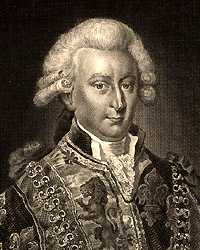John Charles Brooke

John Charles Brooke FSA (27 August 1748 – 3 February 1794) was an English antiquarian and Somerset Herald at the time of his premature death in 1794.
Early life
Brooke was born at Fieldhead in the parish of Silkstone, Yorkshire in August 1748, son of Dr. William Brooke and Alice Mawhood.[1] He was also a descendant of the Rev. John Brooke, rector of High Hoyland, who had himself - in the previous century - been an antiquarian interested in the history of Yorkshire.[2] John Charles Brooke would eventually come into possession of some of the historical material collected by Rev. Brooke, and thus his "taste for historical and genealogical research" was "perhaps inherited."[1][2]
The second of his parents' children, Brooke was sent to London in order to be apprenticed to a chemist named James Kirkby in the Holborn section of the city.[1][2] However "after discovering a strong turn to heraldic pursuits" and attracting the attention of the Duke of Norfolk (Edward Howard at that time), Brooke was able to secure a placement in the College of Arms.[2]
Career
He became Somerset Herald in 1777.
Death
On 3 February 1794 he had attended the Haymarket Theatre in Pall Mall, London with Benjamin Pingo, York Herald. Both men were crushed to death in a crowd of well wishes eager to see the King, at the side door of the theatre. According to Walter Thornbury, "Mr Brooke had died standing, as he was found as if asleep, and with colour still in his cheeks."[3]
King George III had attended the theatre that day and was only told of the deaths of both Officers of Arms after he had departed.
John Charles Brooke is buried in St Benet Paul's Wharf, London, a church closely associated with the College of Arms.
References
- ↑ 1.0 1.1 1.2 Nichols, John (1831). Illustrations of the Literary History of the Eighteenth Century, Volume VI. Oxford University. p. 354.
- ↑ 2.0 2.1 2.2 2.3 Walker, John (1811). Selection of Curious Articles from the Gentleman's Magazine, Volume IV. Longman, Hurst, Rees, Orme, and Brown. p. 398.
- ↑ From: 'Heralds' College', Old and New London: Volume 1 (1878), pp. 294-304. URL: http://www.british-history.ac.uk/report.aspx?compid=45044. Date accessed: 22 January 2008
|